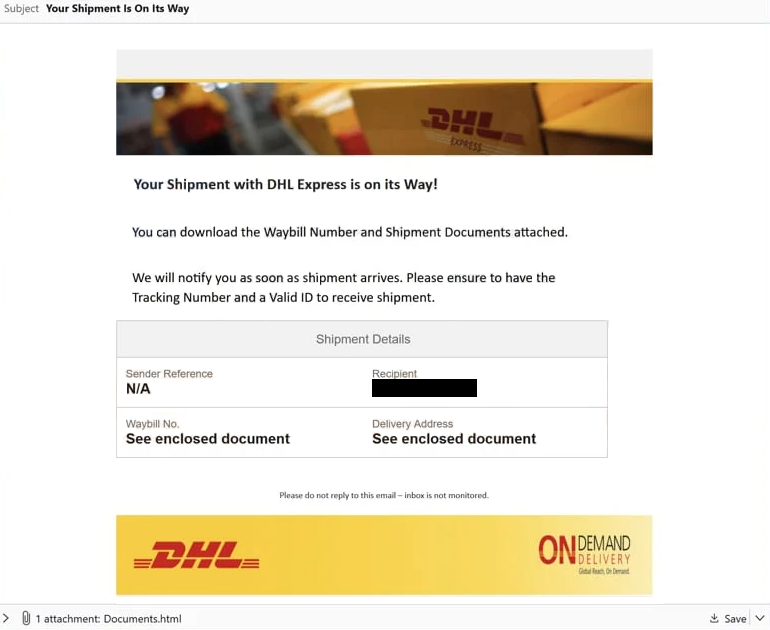Remove “Your Shipment With DHL Express Is On Its Way” malicious email
The “Your Shipment With DHL Express Is On Its Way” email is part of a phishing email campaign that intends to steal users’ email login credentials. The email is disguised as a parcel delivery notification from DHL and claims that the recipient has a delivery on its way. The email has an attachment that supposedly contains the tracking number, and if the recipient clicks on it, they will be taken to a site that asks them to type in their email login password.
Phishing emails disguised as parcel delivery notifications are quite common as users tend to open the attachments or click on links. This particular phishing email claims that a parcel is on its way and contains a “Documents.html” attachment that supposedly contains the tracking number, which users will need to receive the parcel. The email does not provide much information, simply states that it’s all in the enclosed document.
If users open the “Documents.html” attachment, they will be directed to a page that claims the document is locked and requires a login. Entering your email password will result in it being sent to the cybercriminals behind this phishing campaign. These cybercriminals may either use your credentials themselves or sell them to other malicious actors. Email login credentials are highly sought after by cybercriminals because email accounts contain a lot of personal information and they’re linked to various other accounts. If malicious actors successfully take over an account, they could gain access to all other additional accounts and a lot of information.
The full contents of the “Your Shipment With DHL Express Is On Its Way” malicious email are below:
Subject: Your Shipment Is On Its Way
Your Shipment with DHL Express is on its Way!
You can download the Waybill Number and Shipment Documents attached.
We will notify you as soon as shipment arrives. Please ensure to have the Tracking Number and a Valid ID to receive shipment.
Shipment DetailsSender Reference N/A
Recipient –
Waybill No. See enclosed document
Delivery Address See enclosed document
Please do not reply to this email – inbox is not monitored.
Terms of Use | Privacy Notice | Terms and Conditions of Carriage 2024 © DHL Group
How to recognize phishing emails?
Phishing campaigns that send generic emails to many recipients are typically easy to spot because they lack credible information, often contain numerous mistakes, and just generally do not look legitimate. In contrast, more sophisticated phishing attempts are aimed at specific individuals, mentioning personal information to give the email credibility. However, most users deal with generic phishing campaigns.
If you receive an unsolicited email requesting you do something—like clicking a link or opening an attachment—the first step is to verify the sender’s email address. You can do this by searching the address online to check if it corresponds to the stated sender or organization. Sometimes, malicious addresses appear random and suspicious, making them easy to identify. In other cases, cybercriminals may employ tactics to mask the email addresses, such as substituting letters to resemble legitimate companies or adding extra characters. For example, they might add an additional “f” to create a fake Netflix address.
Additionally, you need to watch out for grammar and spelling mistakes, which are common in phishing emails. Though more concise emails may not include many mistakes, glaring ones can still be present. You would rarely find such mistakes in official emails from credible service providers, like DHL. This particular “Your Shipment With DHL Express Is On Its Way” malicious email has several grammar mistakes, which immediately give it away as malicious.
It’s important not to rush into any action when dealing with these emails, especially if they urge you to click a link or open an attachment. Take the time to evaluate the email’s authenticity and consider whether it’s reasonable for you to receive such an email. For example, if you receive this “Your Shipment With DHL Express Is On Its Way” but are not waiting for any package, it’s immediately obvious that you’re not dealing with a legitimate email from DHL.
Finally, when dealing with emails that contain links, it’s advisable to avoid clicking them altogether. If you suspect an issue with an account, access it manually through the official website rather than through any links provided. For instance, if you receive a notification from Netflix about a failed payment, it’s safer to log into your account directly to address the issue.
“Your Shipment With DHL Express Is On Its Way” malicious email removal
If this email lands in your inbox, remove “Your Shipment With DHL Express Is On Its Way” email. Should you have already interacted with the email and provided your email login details, make sure to change your password right away if you can still access your account. Additionally, take a moment to review your account activity for any signs of unauthorized access. If you suspect that your email account has been compromised, reach out to your email service provider for assistance in regaining access. If your email account is no longer accessible, unlink your email from any other accounts to protect them from potential hijacking.
Site Disclaimer
WiperSoft.com is not sponsored, affiliated, linked to or owned by malware developers or distributors that are referred to in this article. The article does NOT endorse or promote malicious programs. The intention behind it is to present useful information that will help users to detect and eliminate malware from their computer by using WiperSoft and/or the manual removal guide.
The article should only be used for educational purposes. If you follow the instructions provided in the article, you agree to be bound by this disclaimer. We do not guarantee that the article will aid you in completely removing the malware from your PC. Malicious programs are constantly developing, which is why it is not always easy or possible to clean the computer by using only the manual removal guide.

